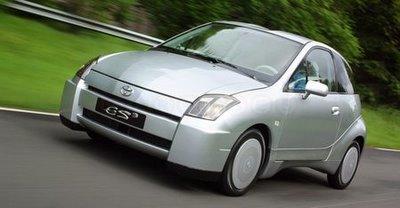
In 2002 Toyota came out with a prototype e-car that surpassed 100 mpg, in tests, and was advertized on Toyotas web site. There was an artical in The London Times on this car, and there were people trying to buy one, but no one could find anything out from Toyota. So there are a few of them around, that have been road tested, with excellent reports on performance and milage, but it is the Prius,which came on the market in 1997 that is on the market. It is a shame that yet another efficient car has dissappeared from the market at a time when we should be doing everything possible to reduce co2, and conserve energy. This is another example of what Al Gore is saying in his latest movie..."An Inconvenient Truth".
In 2002 Toyota came out with a prototype e-car that surpassed 100 mpg, in tests, and was advertized on Toyotas web site. There was an artical in The London Times on this car, and there were people trying to buy one, but no one could find anything out from Toyota. So there are a few of them around, that have been road tested, with excellent reports on performance and milage, but it is the Prius,which came on the market in 1997 that is on the market. It is a shame that yet another efficient car has dissappeared from the market at a time when we should be doing everything possible to reduce co2, and conserve energy. This is another example of what Al Gore is saying in his latest movie..."An Inconvenient Truth".
While the media has focussed its attention on hybrid technology, led by the Toyota Prius, auto engineers have been competing to develop so-called "3-liter cars." This appellation refers to a vehicle that consumes no more than three liters of fuel per 100 kilometers.
Toyota's ES3 (Eco Spirit cubic) ups the ante by reaching the 100km goal on less than 2.7 liters of diesel fuel (EC mode, measured by Toyota). That's well over 100 miles per gallon.
Toyota's Diesel Particulate-NOx Reduction System (DPNR) uses new catalyst technology to bring diesel emissions down to Euro Step IV standards for gasoline-powered vehicles.
Toyota took a multi-pronged approach to achieving efficiency.
Over 100 miles per gallon
First, the ES3 trims curb weight down to 700kg with its aluminum alloy frame, magnesium frame seats, lightweight polymers and other light-yet-strong materials.
Second it uses an aerodynamic form, measuring a drag coefficient of just Cd 0.23.
Third, its powertrain features Toyota's D-4D direct-injection common rail diesel engine with CVT (continuously variable transmission).
Ultra fuel efficient 1.4 liter D-4D direct injection-diesel common rail turbo engine with DPNR (Diesel Particulate-NOx Reduction System).
Adopting techniques from Toyota's hybrid success, the ES3 employs regenerative braking and "Stop & Go" power train management to turn the engine off when the vehicle is stationary.
As part of its total environmental effort, Toyota also carefully chooses materials that are recyclable and do not pose hazards. "Bio-plastic" interior furnishings are made of biodegradable plant materials, wire harnesses are PVC free, and many interior and exterior components such as the bumpers are made of TSOP (Toyota Super Olefin Polymer) which can be recycled to make new parts.
Toyota Displays ES3 at Motor Show in Frankfurt

No comments:
Post a Comment